Rent a car and drive to western Sichuan in the golden autumn (1): Chengdu to Malkan, Taoping Qiang Village, Bipeng Valley
In the golden autumn of 2019, I rented a car and drove a trip to western Sichuan. The driving route: Chengdu → Dujiangyan → Taoping Qiangzhai (Li County) → Bipeng Gou (Li County) → Markang → Xiaojin → Danba → Bamei → Xindu Bridge → Litang → Daocheng → Yading → Litang → Xindu Bridge → Zheduo Mountain → Kangding → Hailuogou → Luding → Chengdu, which is actually the Western Sichuan Small Ring Road plus Daocheng (Aden). Only my eldest son X.J. and I were in the company, He is responsible for driving and all arrangements and expenses during the trip, and I am responsible for planning the driving route.

X.J. was allowed to take a vacation from October 4 to 14 and planned to invite me to drive to western Sichuan with him and let me arrange the specific itinerary. He mainly longed for Daocheng (Aden). However, just a trip to Daocheng (Aden) obviously could not accommodate an 11-day holiday. Therefore, X.J. put forward a vision of "Chengdu → Hailuogou → Kangding → Xindu Bridge → Daocheng Aden → Ganzi → Seda → Miaro → Chengdu". The specific plan is to rent a car in Chengdu and arrange all 11-day holidays during the trip, so that I can help him enrich and improve it. This is actually the plan for the Western Sichuan Grand Ring Road and Daocheng (Aden). However, after inquiry, I found that the essence of Ganzi lies in Daofu. The scenery there is beautiful but very primitive. It is necessary to hike and camp. This is obviously not suitable for us. The main attractions of Seda are Buddhist academies and celestial burial platforms, which are not suitable for X.J., Because he is not interested in temples, he is a character who would rather stare in the square and bask in the sun when he arrives in Lhasa than enter the Potala Palace. Therefore, I suggested changing to the Western Sichuan Small Loop Road and Daocheng (Aden). This road is mainly natural landscapes, which is more in line with X.J.'s appetite. Moreover, the small loop road will choose a clockwise direction, and the altitude rise will be relatively gentle, which can gradually adapt to the plateau. This suggestion was finally approved by X.J., the boss and driver, who both paid and contributed, and had the final say.
On October 4th (D1), I left for Chengdu today. Flight MF8401 took off at 7:35 a.m.. For the convenience of travel, I checked into X.J.'s house last night. Just after five o'clock in the morning, the eldest daughter-in-law L.H. got up to prepare breakfast and cook dumplings. According to the rules of her hometown, relatives need to eat dumplings when they travel far away. My little grandson also woke up early to see us off, and the warmth of the family was deeply touching. We bid farewell to L.H. and our little grandson before six o'clock.


Arrive at Takasaki Airport at 6:20, check in your luggage, pass security, board at 7:05, and take off on time at 7:35. The flight was a Boeing 787, everyone had an exclusive video, and the screen was mounted behind the front seat. This was my first time flying a Boeing 787. Arriving at Chengdu Shuangliu Airport on time at 10:40, the Chengdu company, which provides car rental services, sent someone to pick us up and take us to a store near the South Railway Station for car rental procedures. This is a company headquartered in Xiamen. We rent a car through our headquarters and give us some discounts.
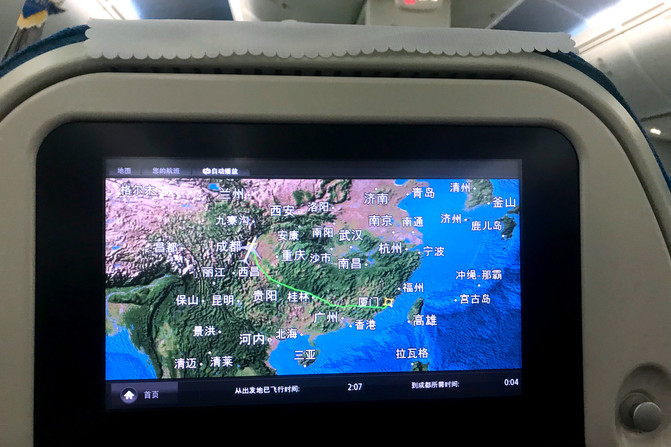

At 11:42, we drove on the road, driving roughly northwest, passing through urban Chengdu, and the target was Dujiangyan. According to my reservation plan, we plan to stay, visit, and have lunch in Dujiangyan, then go to Bipeng Gully, stay at the mouth of the ditch tonight, and visit the ditch again tomorrow morning. I have been to Dujiangyan in 2001. The scenic spot is not big and it takes one hour to take a quick look. "Bipeng Gully" and the "Miaro" originally proposed by X.J. are adjacent scenic spots, but Bipeng Gully was developed later and more primitive. A friend who works in tourism in Sichuan suggested that we choose Bipeng Gully.



At 12:10, we will get on the Ring Expressway at the "Wenjiachang Toll Station of Chengdu-Wenqiong Expressway", then pass through the "Chengdu-Guanshan Expressway Chengdu Toll Station" and turn on the "Chengdu-Guanshan Expressway". At 12:53, we will get off the expressway at the "Dujiangyan" Toll Station. There is no charge for the expressway during the National Day holiday. However, as soon as we drove into Dujiangyan City, we saw a big screen announcement: "Today, the Dujiangyan Scenic Area is full, and tourists without reservations are not allowed to go to the scenic area." Therefore, our Dujiangyan plan fell through. Unable to enter the scenic spot, X.J. decided to have lunch first and chose "Spring Water Steam Stone Pot Fish". After eating, he felt ordinary. He thought it was a local specialty of Dujiangyan, but after asking, he learned that it was Yunnan cuisine.







If you set off after dinner, the first priority is to refuel, because there is not much gas when you pick up the car. Unexpectedly, there were traffic jams everywhere, making it difficult to reach several gas stations indicated by Baidu maps. Helpless, I had to get on the highway first and prepare to find a service area to refuel later. So at 14:55, we passed the "Dujiangyan West" toll station and boarded the "Duwen Expressway" and drove towards Wenchuan. The Duwen Expressway starts in Dujiangyan and ends in Wenchuan. It is an important part of the G4217 Rongchang Expressway and was completed and opened to traffic at the end of 2012. In 2001, I went from Chengdu to Jiuzhaigou, and I also walked through this area. At that time, I traveled from Dujiangyan to Wenchuan along the National Highway G213. I drove along the Minjiang River and felt that the scenery along the way was very beautiful. When I took the highway this time, I always went through the tunnel and didn't see any scenery. Along the highway is also the hardest hit area of the May 12 earthquake in 2008, and collapsed mountains can be seen everywhere.





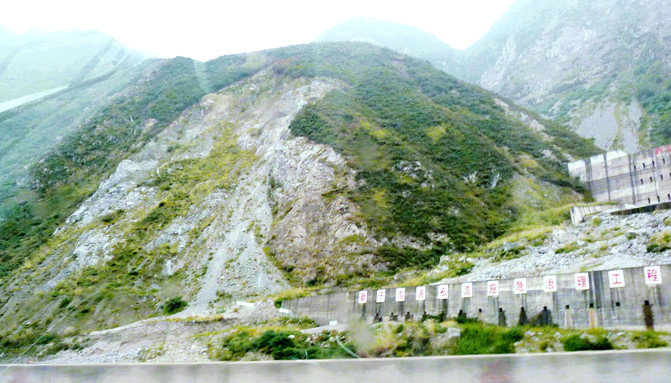

In order to refuel, we searched for service areas all the way. However, there were very few service areas on the Duwen Expressway. It was only at 15:38 that we encountered the first "Mianyang Service Area" and hurriedly drove in. The cars waiting to refuel were already lined up. Long line. Nearby is Dayu's hometown. There is a "Dayu Altar" on the roadside, which can be seen from the highway.



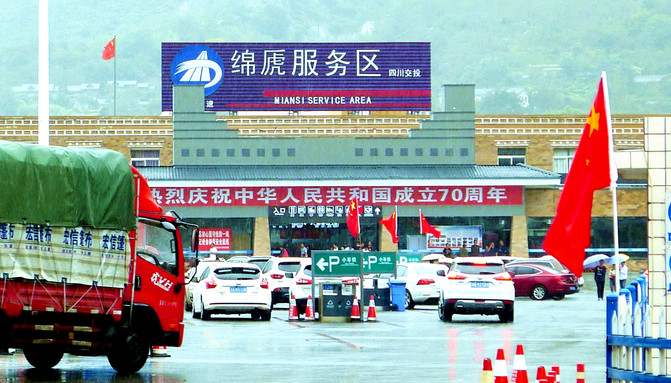

After refueling, we continued on the road and arrived at the Wenchuan Crossing at 16:39. The Duwen Expressway ended here. We did not enter Wenchuan County, but passed through the "Wenchuan Tunnel" to the west and continued to follow the G4217 Rongchang Expressway to the "Malkang" direction. Along the way, the highway also alternates between tunnels and long bridges. The long bridge winds along the trend of the valley. It is an elevated highway in the valley, turning the steep valley into a flat road.

The Rongchang Expressway runs parallel to the National Highway G317, and the G317 can be seen flashing below us from time to time. The current Rongchang Expressway only allows traffic in one direction from Wenchuan to Maerkang, and there are very few vehicles on the road. However, the National Highway G317 under your feet is abnormally congested. At 16:52 due to the closure of the road ahead, he was forced to get off the highway at the "Taoping Toll Station" and diverted to National Highway G317 to continue westward. At this moment, the east to west direction of National Highway G317 is unobstructed, but there is a long queue blocked from west to east. They are all private cars returning to Chengdu after a trip during the National Day holiday. G317, also known as the "Sichuan-Tibet Northern Line" or the "Chengna Line", starts in Chengdu and ends in Nagqu, Xizang.

At 16:55, we drove through "Taoping Qiang Village" and parked for sightseeing. This place was not originally part of our planned project. It was just because the Dujiangyan project fell through and we had more time, so we planned to stop here for a while. "Taoping Qiang Village" is located in Li County of Aba Tibetan and Qiang Autonomous Prefecture, about 40 kilometers away from the county seat, and is located on the roadside of National Highway G317. It is the only well-preserved Qiang ancient village in the world that is still inhabited today. It is known as a "living fossil" of Qiang architecture and folk customs.
The current Qiangzhai is divided into new areas and old areas. The new areas are located on a large area of flat land next to the national highway. They can be entered and exited at will without tickets, and can be directly driven by cars. It is obviously newly built in recent years to develop tourism. The area is mainly filled with hotels, inns, restaurants and shops selling various ethnic handicrafts. It is crowded with tourists during the National Day holiday.






The Qiangzhai Old Area is located on the hillside behind the new area. It is the real "Taoping Qiang Village". The entire ancient village is centered on a tall watchtower, with houses connected and corridors extending in all directions. A radial road network leads from the central watchtower to each exit of the village. The people in the village can advance and retreat freely, but the direction for outsiders entering is difficult to distinguish, as if walking into a maze. Therefore, Taoping Qiang Village is also known as the "Mysterious Oriental Castle". Whether it is a watchtower or a residential building, all buildings in the village are made of local materials, using the rubble abundant in the surrounding mountains, and then using yellow mud as an adhesive. The current Qiangzhai Old Area has been developed into a scenic spot. Tickets are 60 yuan/person. X.J. buys a ticket, but I show my ID card (over 70 years old) to receive the "Ticket Discount Registration Form" to enter for free. The registration form must be signed by yourself and noted "Safety at your own risk". Compared with the hustle and bustle of tourists in Qiangzhai New District (commercial district), the Qiangzhai Old District has few tourists and seems very deserted.


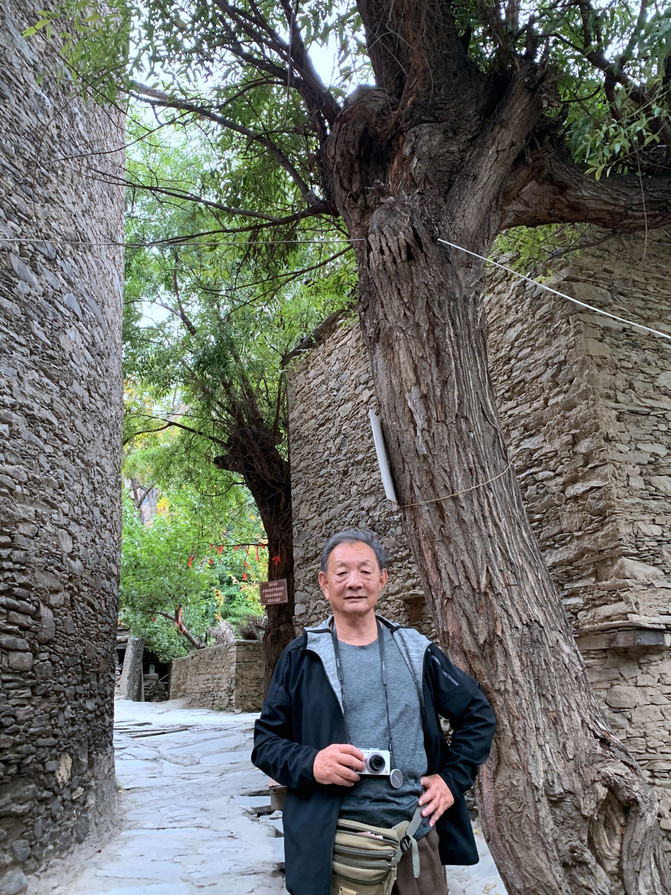

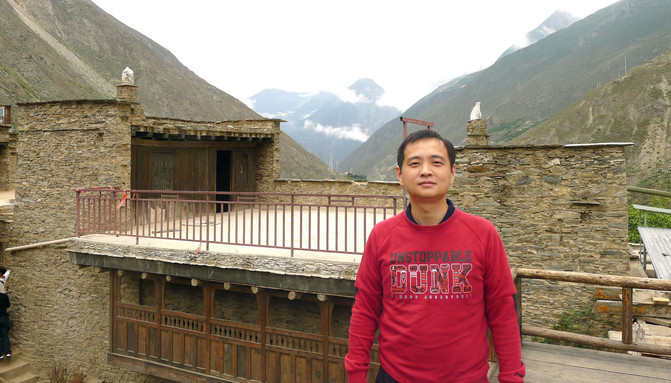
We didn't have much time. After entering the village, we went straight to the watchtower of the "Qiang King's Home", which is the most representative watchtower in Taoping Qiang Village. The passages in the stockade are complex, with narrow and deep alleys. Houses have been built on some alleys. Moving through houses requires transfer of property. Even if there are road signs along the way, we have to ask for directions frequently. At present, there are still hundreds of households in the village. The folk customs are very simple and friendly to foreign tourists.





In the past, the Qiang Village watchtowers were mainly used for military defense. The watchtowers of the "Qiang Wang Family" were about 30 meters high and had nine floors in total. Each floor had shooting ports on the four walls. It was the commanding height of the Qiang Village. We climbed to the roof and looked out. There were dense residential buildings at our feet and another watchtower opposite us. The environment where Qiang Village was located was a deep canyon surrounded by mountains and clouds. The G4217 Rongchang Expressway and the G317 National Highway meandered along the deep valley. The National Day holiday is drawing to a close, and private cars eager to return east are lining up on the national highway.






After leaving Qiangzhai at 18:10, we will continue westward along National Highway G317. A long "white dragon" appears in the mountains ahead. This is a unique cloud scenery on the plateau. In low-altitude areas (such as our Fujian), the clouds and mist between the mountains are often in a diffuse form, and the boundaries are blurred, as if the mist masses on the ground have climbed to the mountains. The clouds and mist on the mountains at high altitudes have clear boundaries. It feels like white clouds in the sky have fallen into the mountains.
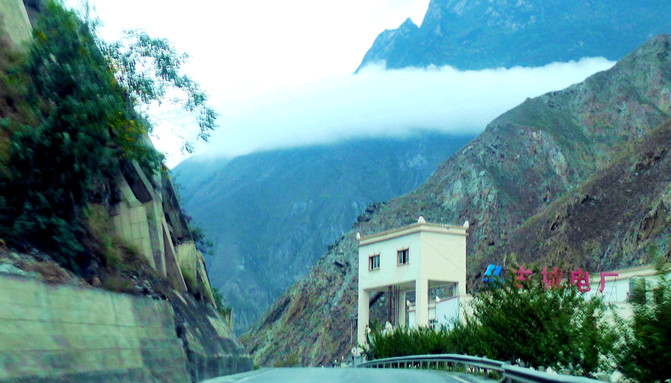
Leaving G317 at 18:25, passing through the "Xuecheng Toll Station" and re-boarding G4217. This section of the highway is still allowed in one direction, only from east to west. Bipeng Gully is located in Putou Township, Li County, Aba Prefecture. We drove through the "Putou" exit and did not get off the highway. We were smart enough to think that "Bipeng Gully", as a famous scenic spot, should have a special exit. Unexpectedly, it was Wulong. We couldn't get off the highway after passing through Bipeng Gully, so we had to continue to move on to the "Gurgou East" highway, then turn around along National Highway G317 and turn back to Bipeng Gully, walking a long way. At 19:44, I checked into the "Shuimu Yuntian Hotel" near the entrance of the scenic spot. Although the facilities were a bit crude, the sanitary conditions were acceptable. The hotel has a restaurant where beef noodles are chosen for dinner.





This hotel is run by local Tibetans. X.J. asked the young man at the reception desk to recommend the best attractions in Bipeng Valley. However, the young man claimed that "because he is a local, I can't feel anything special." This reminds me of visiting Yuanmou's "Bogor Soil Forest" in Yunnan in 2010, a national AAAA scenic spot. An employee of the scenic spot told me that she had been herding sheep in the scenic spot since she was a child and never thought the "soil forest" was beautiful.
On October 5th (D2), the hotel provides breakfast, which is said to be priced at 10 yuan/person, and will be served from 7:30. At 7:58, after breakfast and checking out, the front desk was replaced with a "Han" little girl on duty. She asked if it was Tibetan, but she admitted that it had been sinicized. The ticket office of the Bipeng Valley Scenic Area is 1.5 kilometers away from the hotel and has a wide parking lot. We arrived at 8:04. Because we arrived early, there were many parking spaces and the charge was 20 yuan/day. Tourists must take a sightseeing bus to enter the scenic spot. Bus tickets are sold in bundles with scenic spot tickets. I am free of charge (over 70 years old), but I still need to purchase sightseeing tickets.




Sightseeing buses depart from the ticket office at 8:00 at the earliest. There are many trains. Although there is an endless stream of tourists, the sightseeing buses are still one after another, and they can be boarded quickly after purchasing tickets. Before boarding the bus, I already felt that this place was picturesque, the air was particularly fresh, and the small flowers on the hillside were particularly lively.

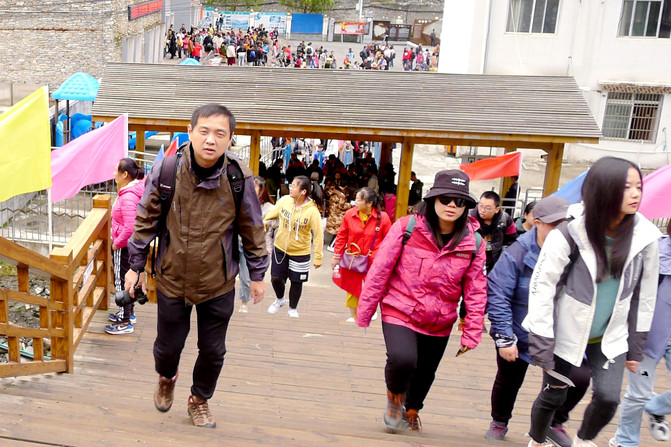


Boarding the sightseeing bus at 8:30, Bipeng Gully is a "natural ecological scenic spot". The sightseeing bus can only go 27 kilometers deep into the scenic spot to reach the "Shanghai Sub-Tourist Service Center" and cannot enter the core area of Bipeng Gully any further. We took a sightseeing bus into the mountains. After the autumn wind and frost, the vegetation in our vision had begun to change. Red, orange, yellow and green were alternately mixed, and the beautiful scenery of Bipeng Gully gradually improved.


Arrive at "Shanghaizi" at 9:17, which is operated by "Li County Bipeng Gully Tourism Development Company." An Min bulletin board indicates that further forward is the core scenic spot of "Bipeng Gully", with a total length of 9 kilometers. Tourists can walk or pay for an environmentally friendly battery car to continue moving forward. Bipeng Gully has beautiful scenery and is roughly divided into 6 viewing areas, including 82 natural attractions and 5 cultural attractions. However, in the entire Bipeng Gully, the two viewing areas of "Panyang Lake" and "Yanzi Rock" are the most visited and most famous. The environmentally friendly battery car is also operated in two sections: the first section is 4.5 kilometers from "Shanghai Zi" to "Panyang Lake", with a one-way charge of 20 yuan/person and a round-trip price of 30 yuan/person; the second section is from "Panyang Lake" to "Yanziyan", which is also 4.5 kilometers, which is also 20 yuan one-way and 30 yuan round-trip.



The "Shanghai Zi" Square was crowded with people, with long queues for ticket purchases and bus rides. The vast majority of tourists came from Chengdu. Bipeng Gully is called the "Back Garden of Chengdu" because it is not far from Chengdu and can travel back and forth on weekends, making it especially suitable for Chengdu people to spend weekends. The National Day holiday is crowded, and sightseeing buses bring tourists one by one, but the scenic area also has many battery cars prepared to send tourists away one by one. It took us about half an hour to queue up here to buy tickets and wait for the bus.



Get on the battery car at 9:46 and drive to the "Panyang Lake" viewing area in about 10 minutes. Perhaps due to the National Day holiday, the battery car was full when it started and did not stop along the way. Therefore, it is located in Shanghaizi (the origin of the battery car) and Panyang Lake (the destination of the battery car). All scenic spots between them are inaccessible to tourists. I visited Siguniang Mountain in September 2007. The transportation in the scenic area is like a bus. It stops at many scenic spots along the way, making it very convenient for tourists to get up and down. I suspect that if I didn't encounter the "golden porridge", the battery cars here would also have intermediate stops. The small square at the outlet of Panyang Lake is the terminal of the battery car. Obviously, due to the artificial dam, a small waterfall is formed at the outlet. Snow mountains can be seen behind the waterfall, and there is also a "white dragon" in the mountains. The scenery is quite spectacular. Panyang Lake is named because of the frequent presence of Pan sheep around it. However, at this moment, there are people everywhere around the lake. The Pan sheep should have long fled away, leaving only one Pan sheep sculpture still standing by the lake.




Panyang Lake is the largest lake in Bipeng Valley, with an altitude of 3676 meters, a water depth of 2-6 meters, and a water area of 450,000 square meters. The water quality is clear and transparent, making it a typical alpine lake. We followed the east bank of the lake, circling the lake from north to south. We surrounded by towering snowy peaks, lush virgin forests, and beautiful scenery. The altitude of Panyang Lake is similar to that of Lhasa, Xizang, but I don't feel anything strange walking through it. There seems to be no lack of oxygen in the air, which should be due to the dense vegetation. While walking, I suddenly saw a girl flying soap bubbles by the water's edge. The picture was beautiful from a distance, so I took a photo with the telephoto.








The footsteps of autumn have arrived in the mountains, the vegetation is changing color, and the coniferous trees are still green, but the broad-leaved trees and shrubs and grass by the lake have long been put on autumn clothes, showing different shades of red, orange and yellow. With thick green trees, deep red autumn leaves, green lake water, blue sky, and white snow on the top of the mountain, Panyang Lake has beautiful scenery and dreamy scenery.





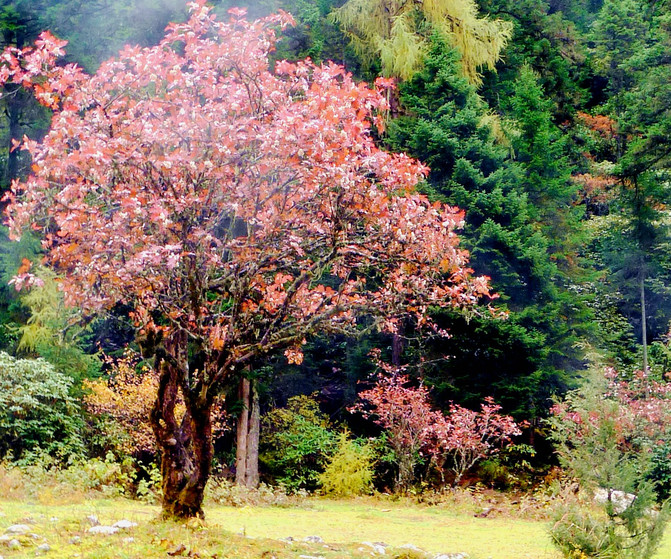


There is a wooden plank road built along the lake. We walked along the long plank road, crossing swamps and wetlands, and circling to the southern end of the lake. There is a large white sandy beach opposite here, deeply inserted into the center of the lake. There is also a crescent moon on it. The sculpture and the scenery are also very beautiful. However, the "golden porridge" is full of people. We didn't go there, but we just took a photo from a distance.

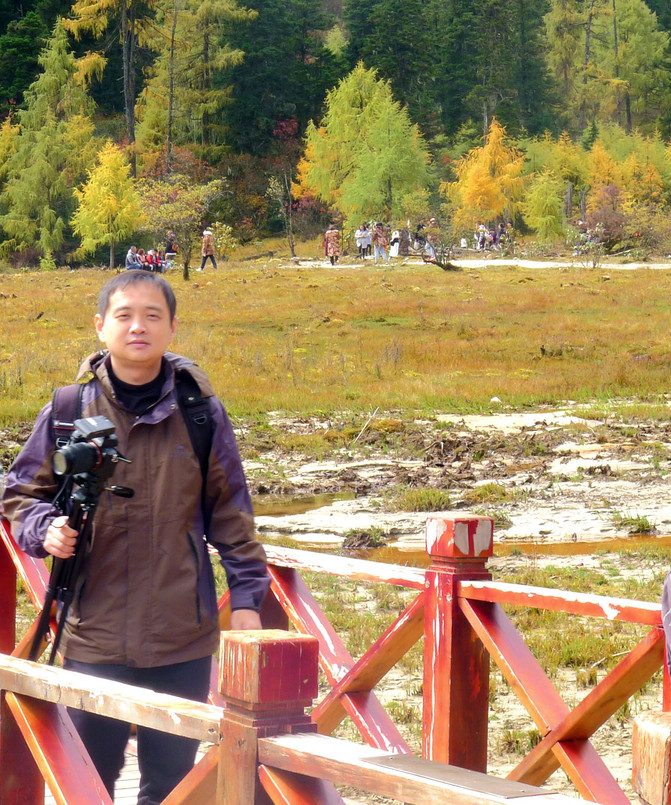

At 11:32, walk to the end of the wooden plank road, which is also the starting point for the environmentally friendly battery car (Panyang Lake → Yanziyan). We bought tickets, lined up, and boarded the battery car again. This time we were going to Yanziyan. The battery car from Panyang Lake to Yanziyan also does not stop halfway, and the 4.5-kilometer uphill road reaches the Yanziyan Scenic Area parking lot in one go. However, the parking lot is still about 500 meters away from the real scenic spot, and you have to climb the mountain on foot after getting off the bus.
Around 12:00, we walked to "Yanzi Rock". This place is 3837 meters above sea level and is surrounded by snowy mountains. There is a large area of alpine grassland in the middle. There is a huge stone engraved with "Yanzi Rock Nest". It is the official name of the scenic area because it is named after swallows built nests on the cliff. Yanziyan is adjacent to the famous "Siguniang Mountain" scenic spot across the mountain. On the back of the snowy peaks on the west and south sides of the mountain are the "Shuangqiaogou" and "Changping Gully" of the Siguniang Mountain Scenic Area. Therefore, Bipeng Gully also has the name of "The Beautiful Back of Siguniang Mountain". During the National Day holiday, the vast meadow was filled with people.


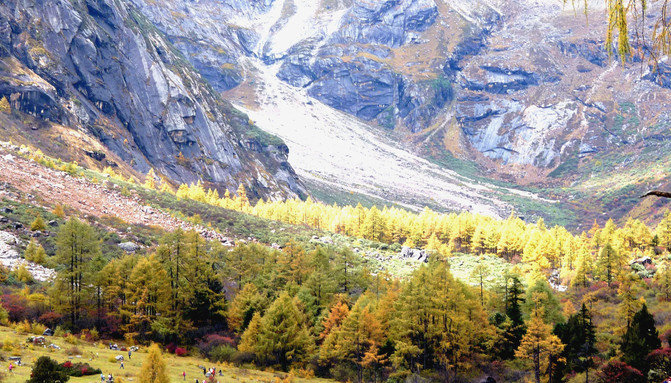




It's already noon, lunch first. Local mountain people set up booths near the entrance of the scenic area to sell sizzling grills. Tourists first choose their own fresh ingredients and then hand them over to the "chef" for processing. X.J. bought two large paper bowls of barbecue with yak meat, pork belly and potato chips for a total of 100 yuan. The meat was abundant and the taste was excellent. I was very satisfied with it. X.J. thinks it's a little expensive, but I consider this a scenic spot, so the price should be okay. A month ago, I had a burger set meal at the "McDonald's" at Xiamen North Railway Station and the "KFC" at Jiujiang Railway Station. The price was both more than 50 yuan, and the hamburgers were only the size of small cups. Compared with this big bowl of "teppanyaki", the price is much lower.




There are tables and chairs in the fence in front of the barbecue greenhouse. We eat delicious food and watch the beautiful scenery. There is a waterfall on the nearby mountain with a drop of 360 meters. It is called the "Flying Dragon Waterfall". Water pours down from the cliff and disappears into the jungle after passing through several layers of rocks. Among them, it seems to be a white dragon flying in the mountains. There is also Hongshi Gully on the opposite mountain. A glacier melt water flows down from the top of the mountain. Red stones are scattered on both sides. The stones appear red because a kind of red algae is attached to their surfaces. This kind of algae has extremely high environmental requirements and cannot survive with a little pollution. The existence of Hongshi also shows that the environment here in Yanziyan is good.


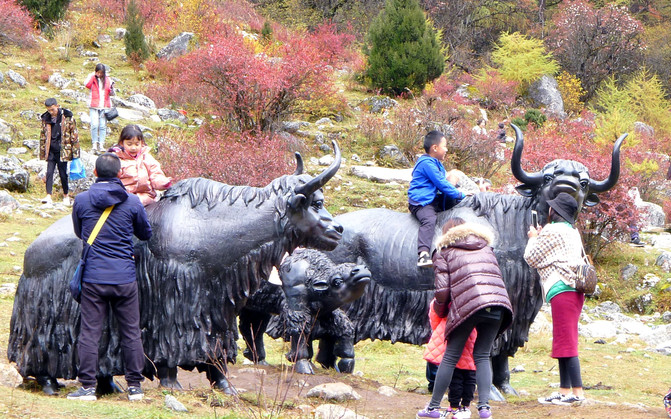

The two walked slowly around the large meadow, stopping from time to time to view and take photos."Yanziyan" is higher than "Panyang Lake", and the autumn color is more intense. Most of the trees in the mountains have been changed into autumn clothes. Moreover, because the leaves gradually change color, even red, orange, yellow, and green have different colors. Looking around, the colors of bright red, light red, orange red, orange yellow, golden, and light yellow blend with the dark green, light green, and yellow green that have not yet completely changed color. Layer upon layer, gorgeous and colorful, bringing us surprises again and again. Autumn leaves are as beautiful as spring flowers. It is really "the annual autumn wind, not like spring light, but better than spring light!"


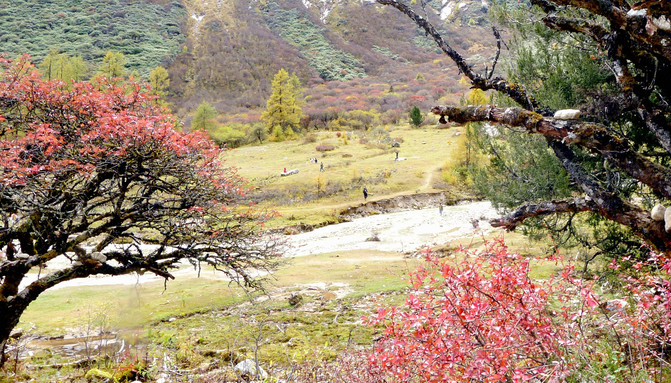

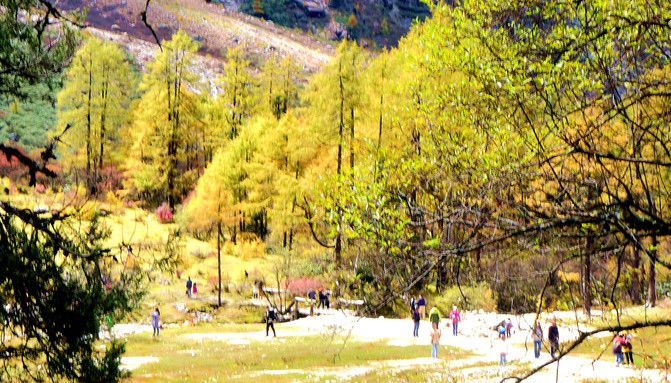




It took about 80 minutes to walk around the great meadow. At an altitude of more than 3800 meters, walking too much would make it difficult, and you would need to breathe heavily from time to time. There were people everywhere during the National Day holiday. When I asked a few people, they all said they were from Chengdu. Some people were traveling with their children and their families, and some even brought a baby who was several months old. I asked what to do in case of altitude sickness, and they all said it was okay. The "high rebellion" did not come just like this. There was a brewing process. They would not stay for too long even when they came up. They would have already gone down the mountain before the "high rebellion" occurred. There is a clear stream in the middle of the grassland. The stream originates from the surrounding snowy peaks. It should also be the water source of Panyang Lake.






At 14:10, I was ready to take the battery car down the mountain. However, at this moment, the tourists waiting for the car were already lined up in a long line of nearly 600 meters, extending from the parking lot to the entrance of Yanziyan Scenic Area, crossing the "barbecue greenhouse", and then towards Nili. Nearly 100 meters. The two had to queue up honestly, sometimes "standing" and sometimes moving. However, while moving, they also saw the "red stone" on the roadside up close. We were able to board the train after waiting in line for about 40 minutes. Unexpectedly, the train had to queue again after arriving at Panyang Lake. The long waiting line in this place had already exceeded the length of Panyang Lake from north to south, and we had to continue to "stop penalty". Finally, I was able to board the bus and arrived at the "Shanghaizi" parking lot at 15:34. Unexpectedly, it would be very smooth to transfer to the sightseeing bus here. Basically, there were only cars waiting for people, and they could go at any time.

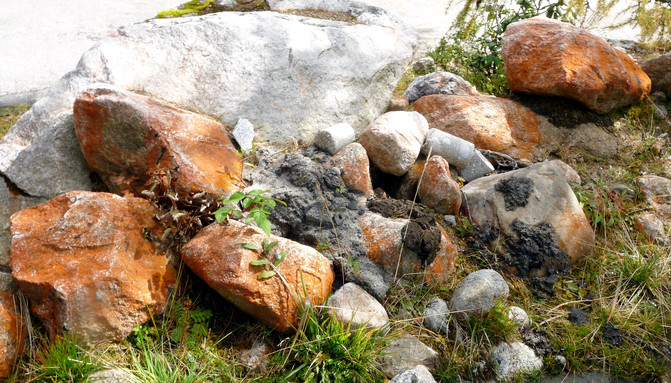

At 16:25, the bus arrived at the parking lot of the "Bipenggou Scenic Area Ticket Office" and found our own car. X.J. felt very tired because of the long "penalty stop". In order to ensure driving safety, he decided to take a nap in the car for a while and started at 16:50. Drive out of the intersection of Bipenggou Scenic Area and turn left onto National Highway G317. The target is "Malkang", the capital of Aba Autonomous Prefecture, where we will stay tonight. At 17:22, I passed through "Gurgou", which is a beautiful town, and at 17:59, I passed through Miaro Town. Compared with the commercial Gurgou Town, the buildings of Miaro Town are more stylish and refined. Gurgou, Miyaruo and Bipeng Gully Scenic Areas are not far away, and the landscapes are very similar. You can only visit one of these three places. At 18:20, we will pass through the "Ganduizhai" toll station and re-enter the G4217 Rongchang Expressway (this section is also known as the Wenma Expressway). At 18:25, we will pass through the Zhujiangshan Tunnel. At 18:55, we will get off the expressway at the "Malkang East" toll station. The "Wenma Expressway" ends here, and the Rongchang Expressway is currently only built here.





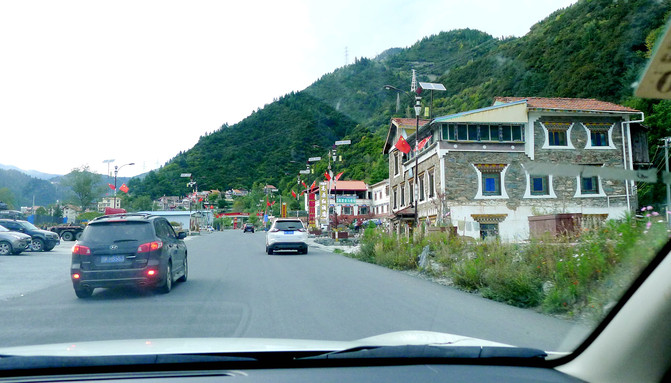







Entering the urban area of "Malkam" at 18:57, and checking into the "Haoting Celebrity Hotel" at 19:03. The room is on the second floor of the annex building. There is no elevator. The room is not big, but the facilities are decent. At around 20 o'clock, we had dinner at the "Luxi Fat Beef" next to the hotel. The hot pot set meal for two people was very exquisite, but the beef rations were not much, and it was arranged in the shape of a Tibetan girl presenting Hada.







Previous Article:Enjoy Jiuhuang Mountain, the perfect combination of Qiang customs and thrills! (Attached is Chengdu cuisine recommendation)
Next Article:Chengdu Slow Travel, tea houses, cafes, bookstores, bars... you will love
